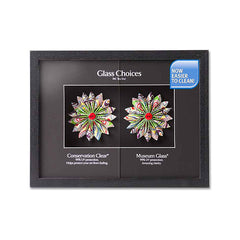Do you sell standard sized frames?
We do not sell pre-constructed standard-sized frames. All of our frames are custom-designed to your specs, so if you like one of our styles, we are happy to send one to you in whatever standard size you need.
How much time will it take to customize my frame?
The average time to complete a custom frame is two-three weeks, which allows for the ordering of any special materials.
What are my options for glazing?
All the glass and plexiglass we offer is 99% UV Protection to protect against the most common problem of sun damage. We offer four types of glazing:
• Museum Glass: Most frequently sold. When it comes to custom framing, this glass product is unmatched in its amazing clarity and uncompromised protection.
• Conservation Clear: Offers slightly lower clarity, but works well with brighter-colored images.
• Optium Museum Acrylic®: Trusted by the world’s most renowned museums, this state-of-the-art glazing boasts a virtually invisible anti-reflective coating allowing viewers to see the finest details in crystal clear color neutrality, while its UV-filtering, abrasion resistant acrylic, and anti-static coating offer uncompromising protection and preservation.
• Conservation Clear® Acrylic: Rest assured you won’t get burned by this ultra protective, crystal clear acrylic that strikes the perfect balance between color neutrality and protection.
Why is UV protection important?
Without at least 97% UV protection, framed pieces will age and fade more rapidly. Indoor and outdoor UV rays contribute to severe color loss, embrittled materials (such as the paper), and general deterioration of framed pieces. Photos may also become yellow or stained with ghostly silver deposits rising to the surface. These effects are both cumulative and irreversible, so choose your level of protection wisely!

What if I need it done in a Rush?
We keep a variety of wonderful frames in stock at all times, so you have plenty to choose from. If you select a frame that is in stock, we can complete the customization in 1-3 days. Of course, this timeline can vary depending on our current workload, so just give us a call and we will be happy to let you know if we can rush your order.
What is the difference between stretching and framing?
When you have art work that is created on canvas, like a painting, it needs to be stretched or pulled over a wooden stretcher. Typically, canvases are not framed the same way as a photograph, as they are different materials with different mediums. Canvases should be stretched with Stretcher Bars that are also custom-made to fit the image size with the excess canvas being stapled at the back of the bar. 
After a canvas has been properly stretched, we recommend framing the piece with a Floater frame.
I need to clean my acrylic plexiglass. What should I use?
To clean your acrylic you can use a micro-fiber cloth and some water, or buy a plastic cleaner. You want to clean these correctly otherwise they can scratch and become damaged.
Which moldings do you have in stock?
We keep our most popular frames in stock, which consist of a variety of colors and sizes. Call us to see what’s currently in!
Do you deliver and how much does it cost?
Delivery costs for assembled frames vary by quantity, size and distance. We only deliver in the NY Tri-State Area, But can ship nationwide. Please call for an estimate.
What’s the difference between conservation materials versus no-conservation?
When trying to decide which materials to choose, consider how valuable the work is to you. If it is an original piece, limited edition, or any other type of treasured work that you want to keep safe and preserved for many years, then choose conservation materials. While they cost a bit more, they protect from UV light damage and their acid-free mats keep the work from yellowing over time.
Why is UV protection important?
Without at least 97% UV protection, framed pieces will age and fade more rapidly. Indoor and outdoor UV light rays contribute to a severe color loss, paper embrittlement and deterioration of framed pieces. These effects are both cumulative and irreversible. The materials that make up the piece, the paper or fabric on which the image is displayed, may become brittle. Photos may appear yellow or stained with ghostly silver deposits rising to the surface. Once damage from light has occurred, it can never be reversed. That’s why it is important to understand what you can do to minimize this type of damage before it happens.